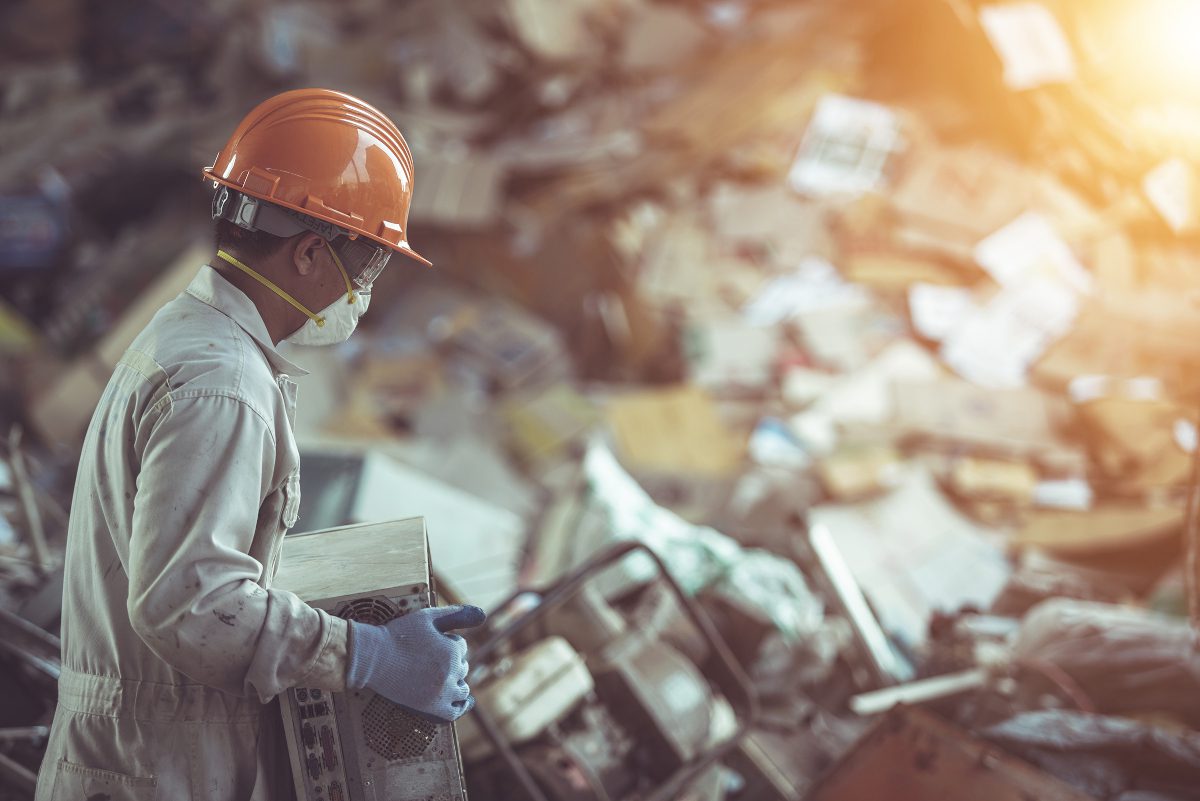
A record 62 million tonnes of e-waste was produced in 2022, up 82% since 2010, and it is on track to rise by a further 32% in 2030, says a report published by the UN on 20 March.
Put another way, the generation of electronic waste is rising five times faster than documented e-waste recycling. The 62 million tonnes generated in 2022 would fill 1.55 million 40-tonne trucks, roughly enough trucks to form a bumper-to-bumper line encircling the equator, according to the report from ITU and the UN Institute for Training and Research (UNITAR).
Meanwhile, less than one quarter (22.3%) of the year’s e-waste mass was documented as having been properly collected and recycled in 2022, leaving US$ 62 billion worth of recoverable natural resources unaccounted for and increasing pollution risks to communities worldwide.
Worldwide, the annual generation of e-waste is rising by 2.6 million tonnes annually, on track to reach 82 million tonnes by 2030, a further 33% increase from the 2022 figure.
E-waste, any discarded product with a plug or battery, is a health and environmental hazard, containing toxic additives or hazardous substances such as mercury, which can damage the human brain and coordination system.
The report predicts a drop in the documented collection and recycling rate from 22.3% in 2022 to 20% by 2030 due to the widening difference in recycling efforts relative to the staggering growth of e-waste generation worldwide.
Challenges contributing to the widening gap include technological progress, higher consumption, limited repair options, shorter product life cycles, society’s growing electronification, design shortcomings, and inadequate e-waste management infrastructure.
The report outlines that if countries could bring the e-waste collection and recycling rates to 60% by 2030, the benefits – including through minimizing human health risks – would exceed costs by more than US $38 billion.
Seconday materials need to step up
As well, it says the world “remains stunningly dependent” on a few countries for rare earth elements, despite their unique properties crucial for future technologies, including renewable energy generation and e-mobility.
Kees Baldé, lead author, UNITAR, noted: “No more than 1% of demand for essential rare earth elements is met by e-waste recycling. Simply put: Business as usual can’t continue. This new report represents an immediate call for greater investment in infrastructure development, more promotion of repair and reuse, capacity building, and measures to stop illegal e-waste shipments. And the investment would pay for itself in spades.”
Among the report’s observations was the fact that collection and recycling rates are highest for heavier and bulkier equipment categories, such as large devices, temperature exchange equipment, screens and monitors.
81 countries had e-waste legislation in 2023, up from 78 in 2019. Of the 81 countries, 67 had a legal instrument governing e-waste management with provisions promoting extended producer responsibility (EPR).
The report said the enforcement of e-waste policy, legislation, and regulation “remains a genuine challenge globally, and the stagnation of the global e-waste collection and recycling rate is likely exacerbated by the fact that only 46 countries have collection rate targets and only 36 have recycling rate targets.”
AI might make things worse?
Responding to the report, Fredrik Forslund, VP of data erasure specialist Blancco, suggested the growth of AI as a factor likely to make things worse, by accelerating the obsolescence of products and components, noting that “the use of AI requires more powerful chipsets, GPUs and CPUs, which, in turn, will require companies to accelerate their IT equipment life cycles.”
“This will create a deluge of equipment and devices that can no longer support AI platforms and applications, which means we will see increased risk of early retirement and physical destruction of such devices.”
“Our goal in the business community is to move away from any physical destruction and identify better reuse strategies, such as cascading equipment internally and updating company policy to ensure confidence in data security and sanitization strategies that enables functional equipment to be repurposed, recycled or donated.”
He added that “more states and countries should adopt Right to Repair laws, which will enable consumers to have their devices repaired, keeping them longer and slowing the buy-use-discard cycle.”
Standout statistics appearing in the report are summarised below.
E-waste key numbers
* 62 million tonnes: e-waste generated in 2022, equal to the weight of 107,000 of the world’s largest (853-seat), heaviest (575 tonne) passenger aircraft – enough to form an unbroken queue from New York to Athens, from Nairobi to Hanoi , or from Hong Kong to Anchorage
* 14 million tonnes (22.3%): estimated mass of e-waste trashed, mostly landfilled, in 2022
* 31 million tonnes: estimated weight of metals embedded in e-waste in 2022, along with 17 million tonnes of plastics and 14 million tonnes of other materials (minerals, glass, composite materials, etc.)
* US $91 billion: The value of metals embedded in 2022 e-waste, including US $19 billion in copper, US $15 billion in gold, and US $16 billion in iron.
* US $28 billion: value of secondary raw materials (mostly iron) reclaimed by “urban mining” of e-waste in 2022
* 900 million tonnes: Primary ore extraction avoided by reclaiming materials through documented e-waste recycling
* 93 million tonnes: CO2-equivalent emissions avoided by formal e-waste management – recaptured refrigerants (41 million tonnes), avoided metals mining (52 million tonnes)
Recycling rates
* 42.8%: Formally documented collection and recycling rates in Europe
* <1%: Formally recycled e-waste in African countries
* ~50% (30 million tonnes): E-waste generated by Asian countries (of which relatively few have enacted legislation or established clear e-waste collection targets)
* 17.6 kg: Per capita e-waste generation in Europe, followed by Oceania (16.1 kg) and the Americas (14.1 kg). These regions also have the highest documented per capita collection and recycling rates (7.5 kg in Europe, 6.7 kg in Oceania and 4.2 kg in the Americas)
* 16 million tonnes: e-waste collected and recycled outside of formal systems in high- and upper-middle income countries that have developed e-waste management infrastructure.
* 18 million tonnes: e-waste managed mostly by the informal sector in low and lower-middle income countries with no e-waste management infrastructure. Any material values recovered by the informal sector are largely (perhaps more than) offset by extremely high health and environmental costs
* 5.1 million tonnes (8.2% of the global total): e-waste shipped across borders in 2022, of which ~3.3 million tonnes (65%) was shipped from high-income to middle- and low-income countries through uncontrolled, undocumented movements
E-waste by category
* 33% (20.4 million tonnes): Proportion of e-waste made up of small devices (eg toys, microwave ovens, vacuum cleaners, e-cigarettes), of which 12% are recycled
* 4.6 million tonnes: e-waste in the small IT and telecommunications equipment category (eg laptops, mobile phones, GPS devices, routers), with only 22% documented collection and recycling rate
* 2.4 million tonnes: Expected mass of retired photovoltaic panels in 2030, four times as much as the 600,000 tonnes in 2022







